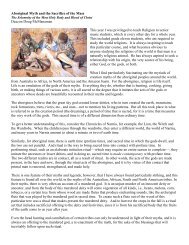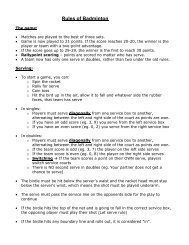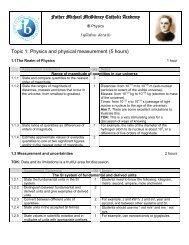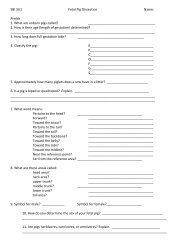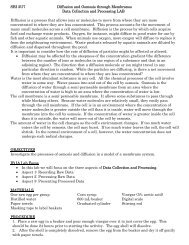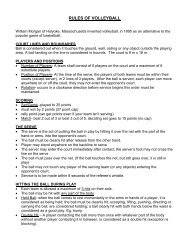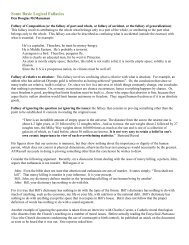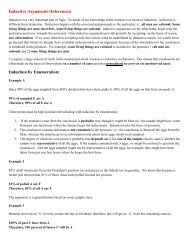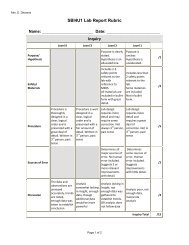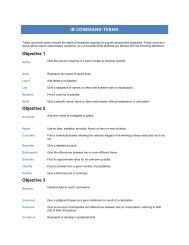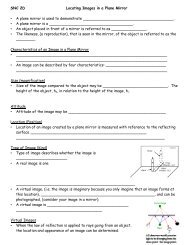Chemistry Review Manual 2
Chemistry Review Manual 2
Chemistry Review Manual 2
You also want an ePaper? Increase the reach of your titles
YUMPU automatically turns print PDFs into web optimized ePapers that Google loves.
(a) Solid calcium carbonate and calcium oxide at 700°C are in a vessel with 0.1 atm partial<br />
pressure carbon dioxide. At 700°C, K = 0.056 for the decomposition of CaCO 3 (s) into CaO(s)<br />
and CO 2 (g).<br />
(b)<br />
Consider the following equilibrium:<br />
Cu 2+ (aq) + 4 NH 3 (aq) Cu(NH 3 ) 4 2+ (aq) K = 6.7×10 12 at 25°C<br />
Suppose [Cu 2+ ] = [Cu(NH 3 ) 4 2+ ] = 1.0 mol L −1 , while [NH 3 ] = 5.0×10 −4 mol L −1 at 25°C.<br />
(c)<br />
Consider the following equilibrium:<br />
SnO 2 (s) + 2 CO(g) Sn(s) + 2 CO 2 (g)<br />
K = 11 atm at some T<br />
Suppose the partial pressure of CO 2 is 3 atm, while that of CO is 1 atm at the required T.<br />
Approach: Compute Q and compare it with K.<br />
(a) Q = p<br />
CO 2<br />
= 0.1 > 0.056. Therefore, there is net reverse reaction. At this partial<br />
pressure, CO 2 in the gas phase combines with available CaO(s) to form CaCO 3 (s).<br />
(b) Here,<br />
( )<br />
2+<br />
3 4<br />
13<br />
1.6 10<br />
2+<br />
4<br />
4<br />
3<br />
[Cu NH ] 1.0<br />
Q = = = × > K<br />
[Cu ][NH ] 1.0 5.0 10<br />
Again, Q > K and there is net reverse reaction.<br />
−4<br />
( × )<br />
(c) Here,<br />
2 2<br />
pCO<br />
3<br />
2<br />
Q = = = 9<<br />
11<br />
p<br />
2<br />
CO<br />
1<br />
In this case, Q < K and there is net forward reaction.<br />
5.4 Shift in equilibrium – le Châtelier's principle<br />
Non-equilibrium conditions can result, starting with an equilibrium mixture, by adding or removing<br />
a reactant or a product. For example, if we have an equilibrium solution with the reaction<br />
CO 3 2− (aq) + H 2 O(l) HCO 3 − (aq) + OH − (aq)<br />
K = 2.1×10 −4<br />
and we dissolve a small amount of NaOH(s) into the solution, a non-equilibrium initial state<br />
results. Increasing the concentration of hydroxide makes Q larger (a factor in the numerator is<br />
increased). Since Q is now larger than K, there is net reverse reaction – product concentrations<br />
decrease, while the reactant concentration increases. Net reaction continues until Q = K is<br />
restored. When equilibrium is re-established, the hydroxide concentration is smaller than it was<br />
immediately after the added NaOH(s) dissolves, but larger than it was before the NaOH(s) was<br />
added.<br />
We can also add a small amount of concentrated sulfuric acid (so as not to significantly change<br />
the total volume) to the solution. The added strong acid reacts completely with OH − present, and<br />
reduces the hydroxide concentration. As such, it removes a product from the chemical reaction.<br />
This has the effect of making Q smaller. Net forward reaction results until equilibrium is reestablished.<br />
Page 44 of 88



